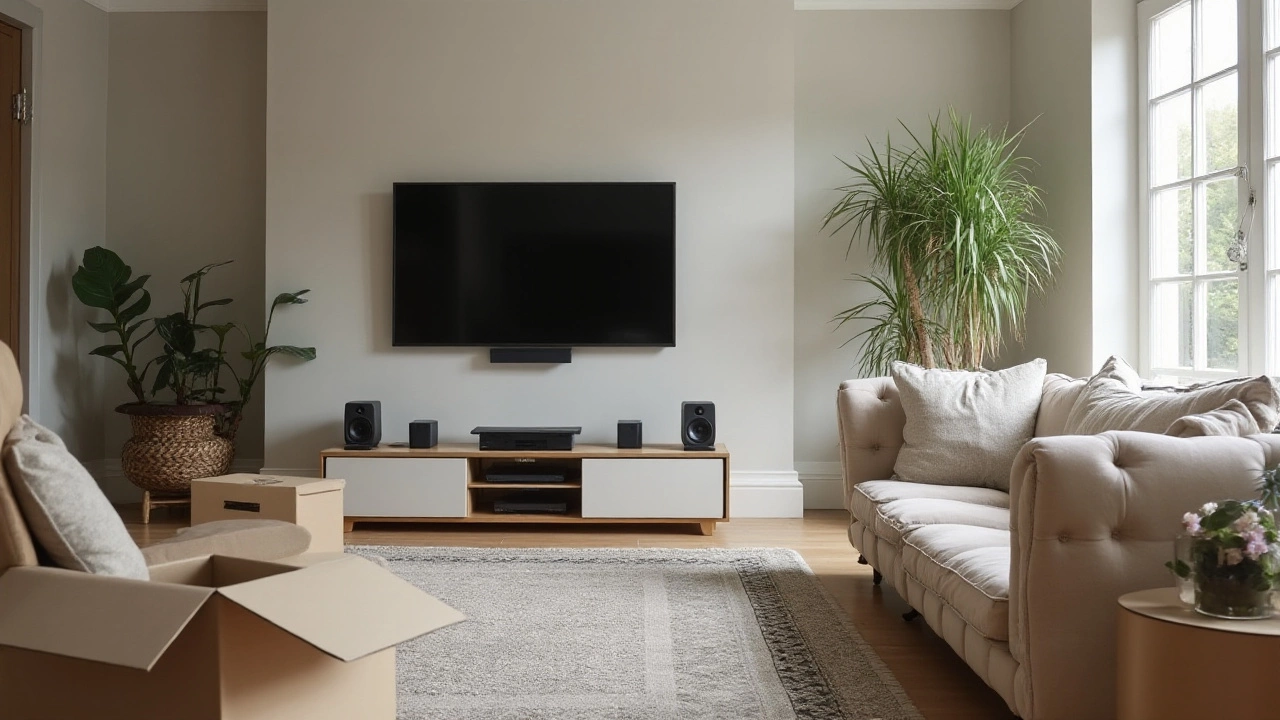When it comes to buying a new home, there are many decisions to make. One question often on the minds of buyers is whether new builds come with a television. You'd think it would be a straightforward answer, but it's not always clear. While some developers might throw in appliances as part of the deal, the inclusion of a television can vary and is usually not a standard feature.
For those stepping into the market for the first time, knowing what's typically included in a new build can save a lot of time and hassle. We'll explore what buyers can usually expect, along with some tips on securing additional amenities. Understanding these nuances helps potential homeowners plan their purchases without unexpected costs or surprises.
- Understanding Standard New Build Inclusions
- Negotiating for Additional Appliances
- Pros and Cons of Developer Packages
- Customizing Your Entertainment Setup
- Budgeting for Home Electronics
Understanding Standard New Build Inclusions
When stepping into the realm of new builds, one of the first queries that crops up concerns what exactly is included as part of the purchase. While it might seem a little dull to some, understanding the standard inclusions could save potential homeowners from unwelcome surprises down the line. Every developer has its own set of standards, but there are some commonalities that typically hold true across the board. Usually, you can expect the essentials that make the home livable from the get-go. That means, usually, a functional kitchen, complete bathroom amenities, and basic light fixtures. The finishes and appliances vary greatly, often depending on the market tier of the home.
In luxury markets, for instance, buyers might find more high-end appliances already in place, but this is far from the norm in entry-level or even most mid-tier properties. So, will your shiny new build come with a television? Chances are, it won't be part of the basic package. Developers tend to focus on structural features and fixed installations rather than moveable electronics. That said, it doesn't hurt to ask about promotional deals or upgrade packages that developers sometimes offer to sweeten the deal. Such packages may come with installed smart TVs and sound systems, especially if the developer is aiming to create a 'move-in ready' atmosphere.
A builder in London recently remarked, "We aim to offer flexibility. Buyers today expect more personalized choices and sometimes, incorporating tech in initial offerings makes sense." The sentiment shared underscores the significance of negotiating with the developers. Larger developments, especially those marketed as high-tech or modern living spaces, are increasingly weaving smart home capabilities into their homes, albeit at an additional cost. If you're a tech enthusiast or have very specific preferences, some new builds might even allow pre-set wiring for an easy integration of various home entertainment systems after you've moved in.
Now, let's talk numbers. In a recent survey of homebuyers, approximately 25% of respondents indicated their houses came with full appliance packages, highlighting how negotiable some inclusions might be. Taking into consideration these factors, it becomes clear that acquiring a new build involves a bit of homework and negotiation prowess. While televisions and such modern amenities aren't customary, they can be part of the larger deal if there's room to negotiate, particularly in a competitive market. Take this as a friendly reminder to not just accept everything at first glance – delve into what's possible, blend it with your desires, and see what magic can be made in your new abode.
Negotiating for Additional Appliances
When you're on the brink of purchasing a new build, the idea of having a fully outfitted home can be quite appealing. While it's typical for developers to provide basic fixtures, getting extra appliances, like a television, may require some savvy negotiation. It's not a given that these items are part of the initial package, but this opens up an exciting opportunity for buyers who are willing to engage in some back-and-forth discussions with developers.
The art of negotiation begins with understanding what a developer is already offering. Sometimes, there are promotional periods where developers might include additional home appliances to entice purchases. For example, during a buyer's market, weakening demand could compel some developers to be more generous with these perks. By keeping a keen eye on market conditions and any promotional offers, buyers stand to gain more from their negotiation efforts.
Research shows that around 20% of new home buyers manage to secure extras like appliances by simply asking for them during the contract phase. It's often just a matter of timing and politely asserting your needs. While some may find this process daunting, it can't hurt to put forward your desires in a courteous manner. Remember, developers want to close the sale, and sometimes they have room to wiggle to make you satisfied. As housing market expert John Matthews once remarked:
"The biggest mistake buyers make is assuming that what's on offer can't be changed. A little negotiation can go a long way."
To approach this strategically, prepare a list of appliances you consider essential. Draft a well-reasoned argument for why these items should be included. Highlight how such inclusions would enhance your satisfaction with the home purchase and potentially streamline your decision-making process. The emphasis should be on mutual benefit, wherein both parties achieve a valuable outcome. If the desire for a television is not part of the initial agreement, articulating its importance to your lifestyle could very well sway the developer's perspective.
Here are a few practical tips when negotiating for appliances: First, maintain a friendly yet firm tone in discussions. Second, do your homework on the appliance brands and models being offered, as different developers might have deals with certain manufacturers. Third, understand your budget flexibility so that negotiations don't stretch your finances beyond comfortable limits. Lastly, don't rush. Giving yourself time to assess each offer and maintain patience can lead to more fruitful negotiations.

Pros and Cons of Developer Packages
When snagging a new build, developer packages often entice buyers with their seemingly convenient offerings. At first glance, these packages promise to make life easier by bundling a host of features and appliances under one deal. For instance, some developers include basics like kitchen appliances while others might even offer high-end finishes or smart home technology. Such packages aim to create a turnkey experience, saving the buyer the hassle of kitting out their new abode. However, it’s always crucial to dig deeper to truly understand the value of these offers.
On the positive side, the convenience factor of these packages cannot be understated. Imagine moving into a home that's ready at the flick of a switch — it's appealing, especially for those scrambling to settle quickly. Moreover, bulk purchasing allows developers to secure discounts on appliances, passing some of these savings onto buyers. Also, having appliances included reduces a buyer's workload in coordinating deliveries and installations. It tackles logistical headaches by ensuring that items fit seamlessly into newly constructed spaces.
Despite the advantages, potential drawbacks keep many buyers cautious. One major point is the lack of personalization. Buyers attracted by customized features might find developer packages restrictive. Standardized options might not align with a buyer’s taste, or they could necessitate upgrades, leading to additional costs later. The perceived value might also distract buyers from scrutinizing finer details, including the durability and efficiency of provided appliances. A basic TV included in a package may not match the buyer’s specific entertainment needs or quality expectations.
"Developer offers are often attractive but examining the details of what’s included and the quality of those items is essential," states Sally Soderquist, a residential property consultant.Consider, too, the long-term impact of accepting basic developer packages. Buyers might face challenges upgrading or replacing items tied into initial setups, especially when dealing with integrated systems.
Financially speaking, developer packages often disguise the true costs of included features. Hidden within the asking price of the home, these packages make it difficult for purchasers to fully evaluate whether they’re getting their money’s worth. Even if some savings are initially had by opting for a package, it often limits negotiations for other aspects of home buying, like stamp duty incentives or landscaping. However, savvy buyers might choose to negotiate on certain package elements to tailor options more closely to their lifestyle. A table below shows the typical elements included in a developer package compared with potential additional costs for custom options:
| Package Element | Included in Package | Custom Option Costs |
|---|---|---|
| Kitchen Appliances | Standard Included | £1,000-£7,000 |
| Smart Home Features | Basic Level | £500-£2,500 |
| Television | Standard HD Model | £400-£1,500 |
In the end, weighing the benefits and downsides of developer packages is essential for anyone considering a new build. Buyers should approach these offers with both enthusiasm and caution, ensuring due diligence is done. Whether one leans towards maximum convenience or craves more personalized setups, understanding and negotiating these packages plays a vital role in securing a home that truly fits within one’s vision and budget.
Customizing Your Entertainment Setup
Embarking on the journey of customizing your entertainment setup in a new home is both an exciting and a challenging endeavor. The allure of creating a highly personalized space that caters to your family's viewing and listening pleasures requires careful planning and a dash of creativity. Today's technology provides an array of options that can transform living rooms into immersive home theaters, yet the task remains—how to best integrate these components into your new living space. Begin by assessing the size and layout of the primary entertainment room, because the dimensions and aesthetics will influence everything from screen size to speaker placement. A room that is intended for family gatherings may prioritize diverse seating options rather than optimizing for acoustics.
Once you've gauged the space, it's time to focus on the equipment that'll bring your entertainment dreams to life. The television, undeniably the centerpiece for many, should be proportionate to the room. Experts recommend that the optimal viewing distance is approximately 1.5 times the size of your screen. For example, if you've opted for a 65-inch television, maintain a viewing distance of around 8 to 10 feet. It's also vital to consider the TV's resolution; with availability ranging from HD to 4K and even 8K, ensure the content you're consuming matches the technology. The addition of a sound system radically enhances the viewing experience. A decent investment in a soundbar or a full surround sound system, depending on the layout, can create a theater-quality atmosphere.
"A well-thought-out entertainment space is a harmony of both form and function," notes renowned audio-visual designer Julie Perez. "It's not just about putting high-tech products together, but integrating them into your lifestyle and home environment in a cohesive way." This approach is echoed by many industry professionals who stress the importance of blending technology seamlessly with everyday living.
After solidifying the central components, it's time to accessorize! Many forget that smaller gadgets and in-room lighting play a crucial role in setting the mood for your entertainment sessions. Consider smart lighting solutions that can be dimmed and adjusted to suit different types of content. Whether it's game night with friends or a quiet movie evening, lighting can alter perception and enhance enjoyment. Don't hesitate to explore smart home integrations that allow voice control over your devices, ensuring all your entertainment twists are just a command away.
| TV Resolution | Recommended Viewing Distance |
|---|---|
| HD (720p) | 1.5 - 2 times the screen size |
| Full HD (1080p) | 1.5 times the screen size |
| 4K Ultra HD | 1 - 1.5 times the screen size |
Finally, don't overlook the aesthetic elements such as furniture arrangement and wall decor, which should complement your home appliances and create a harmonious balance between tech and comfort. Custom shelving for media players and consoles can enhance both function and style, preventing clutter and ensuring easy access to all necessary connections. In sum, while the technology might be the star, it's the thoughtful integration and arrangement within your home that provides a true cinematic experience. Tailor your setup to reflect your taste and daily routines, and you'll have a space that not only meets your entertainment needs but also becomes a cherished part of your home life.

Budgeting for Home Electronics
Getting into a new home is already financially heavy, and the addition of modern appliances can feel like yet another burden. However, planning your home electronics budget thoughtfully makes all the difference. Start by identifying what you'll definitely need right away. Do you plan to have that cinematic experience in your living room? If so, a quality TV setup is a priority. Begin with the essentials and consider energy-efficient models, which may have higher upfront costs but promise savings on energy bills. Once you have a scope, compare prices across different retailers. Seasonal sales can offer substantial discounts, providing an opportunity to get more for less. If new isn't a strict requirement, exploring refurbished models from reputable brands could be another way to stretch the budget.
There is also something to be said about future-proofing your purchases. In today's fast-paced tech world, buying a state-of-the-art device can mean it's obsolete sooner than you'd like. Look for devices that offer update features or support newer tech through accessories or software updates. This way, you're not thrown back into the market quicker than you'd planned. To avoid blowing the budget, set a ceiling ahead of time. Knowing exactly how much you're willing to spend prevents impulse purchases when presented with flashy sales pitches. Allocate funds not just for the main devices, like your television, but also for the add-ons. Besides cables and mounting services, there's the potential need for network upgrades or furniture adjustments to accommodate your setup.
Television sizes and capabilities can greatly vary, and often consumers face the conundrum of splurging on that extra feature versus keeping within their budget. Today’s models offer a lot more than they used to—think smart capabilities, enhanced sound systems, and varying screen types like OLED and QLED. Research is key here, particularly understanding which features offer real value to your viewing habits. "The best choices are made by those who understand their exact needs and the product matches," says tech critic Joan Fields. Often, we find more satisfaction when our purchases align with personal lifestyle needs over trending specs.
Tables showcasing some interesting stats, like the average spend on new build electronics versus second-hand, can prove illuminating:
| Type | New | Second-hand |
|---|---|---|
| Television Setup | $800–$1500 | $400–$700 |
| Sound System | $500–$900 | $200–$450 |
An insightful tip for maintaining budget satisfaction involves communication with the builders or sellers of your new home. Some offer packages where the electronics are tied in from the get-go, allowing for smoother transitions and potential cost savings. While not as common in the UK as in some other regions, personalization of appliances in new builds is growing, and developers may flexibly work within your choices and budgets.
In sum, the approach to unpacking a home electronic budget is multi-faceted. Start with what's necessary, embrace a bit of future-thinking, weigh the real against the ideal, and don't shy away from the unconventional—like pre-loved tech. Decisions made with a rational mind rather than sparkly eyes ensure that the comfort and enjoyment of a new home life start on the right financial foot.
